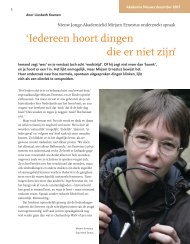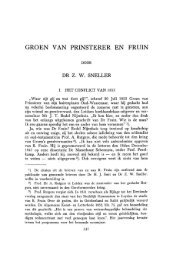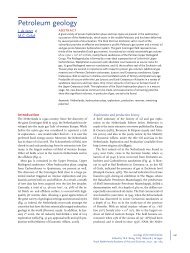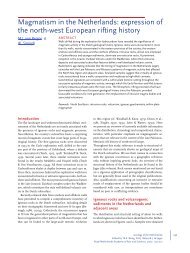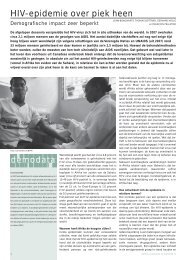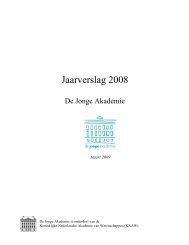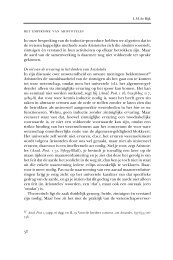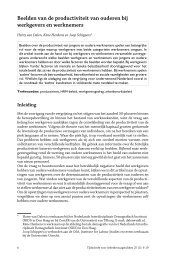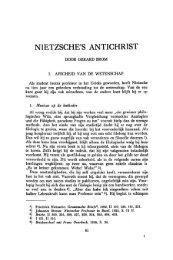Silesian > JM van Buggenum & DG den Hartog - KNAW
Silesian > JM van Buggenum & DG den Hartog - KNAW
Silesian > JM van Buggenum & DG den Hartog - KNAW
Create successful ePaper yourself
Turn your PDF publications into a flip-book with our unique Google optimized e-Paper software.
<strong>Silesian</strong><br />
J.M. <strong>van</strong> <strong>Buggenum</strong> &<br />
D.G. <strong>den</strong> <strong>Hartog</strong> Jager<br />
Introduction<br />
In the Netherlands the <strong>Silesian</strong>, i.e. Late Carboniferous deposits<br />
are thicker and more widespread than those of any<br />
other Phanerozoic period. They are present below more<br />
than 95% of the country and its adjacent North Sea area,<br />
and even after major compaction, the package can be up to<br />
5.5 km thick. This means that the <strong>Silesian</strong> is often thicker<br />
than all overlying sediments together (Fig. 1).<br />
The Carboniferous of north-west Europe has been the<br />
subject of geological studies since the 18 th century. The<br />
early interest may be explained by the excellent outcrops<br />
in the region, even within the Netherlands, and the presence<br />
of coal. For example, the landmark overview article<br />
on the Paleozoic of the Netherlands by Thia<strong>den</strong>s (1963)<br />
contains more than 20 pages on the Upper Carboniferous<br />
and just one page on the Rotliegend.<br />
Both in Britain and in the Netherlands, the Carboniferous<br />
was among the earliest targets for hydrocarbon exploration.<br />
Coevor<strong>den</strong>, the first commercial gas field in<br />
north-west Europe, named after the nearby town which<br />
already had a gas-distribution network in 1951, produces<br />
from both the Carboniferous and the Zechstein. Of its<br />
initial reserves, 33 × 10 9 m 3 of gas are in Westphalian<br />
reservoirs, first appraised by well Coevor<strong>den</strong>-3 in 1951. Offshore,<br />
the first Carboniferous gas was discovered in 1974<br />
in well K4-1D. A major breakthrough followed in the period<br />
1984–1986 with the discovery of the D15-FA field,<br />
and of Schooner, Ketch, Murdoch and Caister in nearby<br />
UK quadrant 44. Unfortunately, poor reservoir quality and<br />
lack of lateral continuity often resulted in disappointing<br />
field developments.<br />
abstract<br />
A thick <strong>Silesian</strong> sequence was deposited throughout the Netherlands and its adjacent North<br />
Sea area. Despite intense erosion during the Late <strong>Silesian</strong> and Early Permian much of it<br />
remains beneath the Permian and post-Permian successions. The preserved thickness locally<br />
exceeds 5500 m. The sequence comprises mainly siliciclastic sediments, deposited in a<br />
foredeep basin that formed as a result of the collision between the northward drifting<br />
Gondwana and Laurussia continents. The Variscan orogenic belt, the centre of this collision,<br />
formed the sediment source for the southern part of the basin. Sediments in the north were<br />
sourced from the Caledonian Mountains. The lithology ranges from claystone, siltstone and<br />
sandstone up to conglomerate. The units were first deposited in a lacustrine, occasionally<br />
marine basin bordered by deltas, alluvial plains and fans, and finally in a largely fluvial,<br />
red-bed environment. Peat was deposited from the Namurian C until the Early Westphalian D<br />
in deltaic and floodplain environments. The coal, which formed when this peat became<br />
deeply buried, has been mined in the southern Netherlands from medieval times until 1974.<br />
Combustible gas (mainly methane), originating from <strong>Silesian</strong> coal, was an early exploration<br />
target of the petroleum industry. Since the discovery in 1951 of gas in <strong>Silesian</strong> reservoirs in<br />
the Coevor<strong>den</strong> field, numerous other discoveries have been made in the east and north-east<br />
Netherlands from the 1950s onward, and in the offshore from 1974 until now.<br />
Keywords: Netherlands, Pennsyl<strong>van</strong>ian, stratigraphy, paleogeography, tectonics, Variscan,<br />
coal, hydrocarbon resources, igneous rocks<br />
Despite many decades of research, numerous aspects of<br />
the <strong>Silesian</strong> remain elusive. The scarcity of clear marker<br />
beds in outcrops and wells, as well as dating uncertainties<br />
have long frustrated the setting up of an unambiguous<br />
regional stratigraphic framework. The thick clastic<br />
<strong>Silesian</strong> packages may appear monotonous on quick view,<br />
but detailed investigations reveal that rapid lateral facies<br />
changes are common. Publications of investigations on<br />
the <strong>Silesian</strong> of the former coal mines in southern Limburg<br />
are numerous. However, results of these studies are not<br />
always representative for the Carboniferous Basin elsewhere<br />
in the Netherlands. Publications outside the coalmining<br />
area are rare because the <strong>Silesian</strong> is deeply buried<br />
and only penetrated by wells drilled by petroleum companies<br />
that tend to keep their findings to themselves. The<br />
authors of this chapter had access to, and participated<br />
in, investigations of wells primarily drilled by the Nederlandse<br />
Aardolie Maatschappij (NAM). The investigations<br />
were compiled in regional studies and, together with gasproduction<br />
experience, have yielded new information that,<br />
as this chapter attempts to summarise, adds much to the<br />
knowledge gathered in the coal mines.<br />
Structural setting<br />
During the <strong>Silesian</strong>, the northward drifting Gondwana<br />
continent caught up with the Laurussia continent. The collision<br />
of the African part of Gondwana with the European<br />
part of Laurussia took place near the equator and resulted<br />
in the formation of the Variscan orogenic belt (Fig. 2). The<br />
Variscan Mountains formed the main sediment supply to<br />
Geology of the Netherlands<br />
Edited by Th.E. Wong, D.A.J. Batjes & J. de Jager<br />
Royal Netherlands Academy of Arts and Sciences, 2007: 43–62<br />
43
NNW SSE<br />
OFFSHORE ONSHORE<br />
0<br />
A E F L<br />
Noord-Holland Utrecht Gelderland<br />
Limburg<br />
Noord-<br />
Mid<br />
North Sea<br />
High<br />
Step Graben<br />
(Close to Elbow Spit High)<br />
Dutch Central Graben Vlieland<br />
Basin<br />
Texel-<br />
IJsselmeer<br />
High<br />
Central<br />
Netherlands<br />
Basin<br />
Peel Block<br />
ext<br />
Maasbommel<br />
High<br />
Roer Valley<br />
Graben<br />
Campine Basin<br />
(Rhenish<br />
Massif)<br />
Campine Block<br />
Brabant<br />
Depth (km)<br />
1<br />
2<br />
3<br />
4<br />
5<br />
6<br />
7<br />
8<br />
100 km<br />
Total section length: 582 km<br />
Vertical exaggeration: 39x<br />
Zechstein<br />
Lower Cretaceous /<br />
Jurassic<br />
Triassic<br />
Rotliegend<br />
West. D<br />
West. C<br />
West. B<br />
West. A<br />
Tertiary / Quaternary<br />
Fig. 1. Longest possible geological cross-section through the Netherlands<br />
on- and offshore, showing the overall structure of the relatively thick<br />
<strong>Silesian</strong> (Namurian and Westphalian) and its overbur<strong>den</strong>. The Stephanian<br />
is not expected to occur in this section (cf. Fig. 13). The section also shows<br />
locations of structural elements mentioned in the text.<br />
Chalk<br />
the foredeep basin north of this belt. Another supply originated<br />
from the ‘passive’ Caledonian hinterland north of<br />
the basin.<br />
In the early phase of the collision, during the Namurian,<br />
rapid and uniform flexural subsi<strong>den</strong>ce took place throughout<br />
the Carboniferous Basin, with progressive onlap of<br />
siliciclastic sediments over the Dinantian platform carbonates<br />
of the London-Brabant Massif and the Mid North<br />
Sea High. A thick package of Namurian sediments in<br />
the Rhenohercynian Zone (Drozdzewski, 1993) and contemporary<br />
igneous intrusions suggest the presence of<br />
subduction systems to the south of this zone (Ziegler,<br />
1990). Three subduction zones, two south- and one northdipping,<br />
associated with Variscan deformation-front sutures,<br />
can be recognised between the Rhenohercynian<br />
and the more southerly Moldanubian Zone (Ziegler et al.,<br />
2004). Within the Dutch part of the basin, <strong>Silesian</strong> extrusives<br />
are recorded from onshore well Steenwijkerwold-1<br />
(Overijssel) and inferred from ‘hard’ seismic reflections at<br />
44 <strong>Silesian</strong> > J.M. <strong>van</strong> <strong>Buggenum</strong> & D.G. <strong>den</strong> <strong>Hartog</strong> Jager<br />
Westphalian<br />
A<br />
Namurian<br />
Dinantian<br />
and older<br />
Zechstein/Rotliegend<br />
the southern flank of the Elbow Spit High in the northern<br />
offshore.<br />
During the Westphalian, the Variscan deformation front<br />
continued to migrate northward and the Namurian sediment<br />
package of the Rhenohercynian Zone was deformed<br />
into major thrust and nappe complexes (Ziegler et al.,<br />
2004). During the early formation of these complexes in<br />
the Westphalian A and B, the foredeep basin to the north<br />
continued to subside. In Germany, inversion-related uplift<br />
occurred from the Late Westphalian C onward. This<br />
continued throughout the Stephanian with an increase<br />
in magnitude and culminated during the Asturian phase,<br />
when a change in stress regime caused transpressional<br />
movements along NW-SE striking faults, as well as block<br />
tilting and the formation of NW-SE trending anticlines.<br />
The impact of this phase in the North Sea Basin is difficult<br />
to assess, since its effects became obscured by Early Permian<br />
thermal uplift and the subsequent substantial erosion<br />
of Carboniferous sediments.<br />
Stratigraphy<br />
Chrono- and lithostratigraphy<br />
The north-west European Carboniferous has traditionally<br />
been subdivided into a carbonate-dominated Lower Car-<br />
Midi Overthrust
Fig. 2. Structural setting of the <strong>Silesian</strong> in north-west Europe<br />
(mainly after Ziegler, 1990).<br />
boniferous and a siliciclastic Upper Carboniferous part.<br />
The lower part has been named the Dinantian and the upper<br />
part the <strong>Silesian</strong> subsystem. The actual Lower–Upper<br />
Carboniferous, i.e. Mississippian–Pennsyl<strong>van</strong>ian chronostratigraphic<br />
boundary occurs at a stratigraphically higher<br />
level, close to the boundary between Namurian A and Namurian<br />
B (Fig. 3; Riley et al., 1994). The chronostratigraphic<br />
subdivision and correlation within the <strong>Silesian</strong><br />
are based on macroflora, palynology (pollen and spores),<br />
‘marine bands’ (calcareous claystone layers with marine,<br />
brackish or fresh-water faunas), weathered volcanic ash<br />
layers (‘Tonsteine’) and radiometric (Ar/Ar sanidine, U/Pb<br />
zircon and Pb/Pb zircon evaporation) ages of the ash layers<br />
(Menning et al., 2000).<br />
The lithostratigraphic subdivision of the <strong>Silesian</strong> Limburg<br />
Group into subgroups is based on the recognition of<br />
four regressive cycles (Van Adrichem Boogaert & Kouwe,<br />
1995). Based on a dominant or typical lithofacies characteristic,<br />
these subgroups are regionally subdivided into formations<br />
(Fig. 3). The boundaries of the subgroups and<br />
formations are diachronous. The lithology of these units<br />
ranges from claystone, siltstone and sandstone up to conglomerate<br />
(Fig. 4). The units were deposited in a lacus-<br />
trine, occasionally marine basin, bordered by deltas, which<br />
developed into a basin with alluvial plains and fans. Peat<br />
was deposited from the Namurian C until the Early Westphalian<br />
D in deltaic and floodplain environments. A basinwide<br />
peak in peat development took place during the Late<br />
Westphalian B and Early Westphalian C with the deposition<br />
of the Maurits and Westoe Coal formations.<br />
Regional correlation<br />
The stratigraphy, correlation and nomenclature of the <strong>Silesian</strong><br />
have long been a matter of debate. As a result of successive<br />
congresses on Carboniferous stratigraphy in the<br />
Dutch coal-mining town of Heerlen between 1927 and<br />
1955, some common ground was reached with the definition<br />
of north-west European series and stages that can<br />
be recognised basin-wide, i.e. Namurian A, B, C, Westphalian<br />
A, B, C, D and Stephanian. However, complex<br />
basin geometries, very thick sequences, the scarcity of<br />
marker fossils and the often endemic faunas and floras<br />
complicated stratigraphic correlations. Together with imperfect<br />
communication between scientists in countries in<br />
or around the Carboniferous Basin this led to an incomplete<br />
and often ambiguous stratigraphic nomenclature.<br />
This situation markedly improved when the British Geological<br />
Survey published their standard lithostratigraphic<br />
Geology of the Netherlands 45
Fig. 3. Stratigraphic scheme for the <strong>Silesian</strong> of the<br />
Netherlands (after Van Adrichem Boogaert & Kouwe, 1995).<br />
nomenclature of the UK southern North Sea (Cameron,<br />
1993), followed by the Netherlands nomenclature compiled<br />
by the Rijks Geologische Dienst, the then Dutch Geological<br />
Survey (Van Adrichem Boogaert & Kouwe, 1995).<br />
In this chapter, simplified versions of both nomenclatures<br />
are compared and upgraded to honour additional information<br />
from recently released but often not published well<br />
data (Fig. 3).<br />
Seismic character<br />
The seismic character of the <strong>Silesian</strong> is very much associated<br />
with the presence or absence of coal within the<br />
sequence. The high impedance contrasts of the coal-toshale<br />
and coal-to-sandstone contacts generate continuous<br />
seismic reflections, which are often grouped in easily<br />
recognisable ‘reflective packages’ (E<strong>van</strong>s et al., 1992;<br />
46 <strong>Silesian</strong> > J.M. <strong>van</strong> <strong>Buggenum</strong> & D.G. <strong>den</strong> <strong>Hartog</strong> Jager<br />
Quirk, 1993). The relatively low impedance contrasts between<br />
claystones and sandstones create only weak seismic<br />
reflectors in overall rather ‘transparent’ packages. Figure<br />
5 displays an example from the Dutch offshore with<br />
a sandstone-dominated transparent package of the Klaverbank<br />
Formation (Westphalian A), a coal-dominated reflective<br />
package of the Maurits Formation (Westphalian B<br />
and Lower Westphalian C) and a sandstone and claystonedominated<br />
transparent package of the Hospital Ground<br />
and Step Graben formations (Upper Westphalian C and<br />
Westphalian D).<br />
Sedimentary cycles<br />
The largest-scale cycle, which can be recognised, is the<br />
overall regressive cycle of the Limburg Group (Figs 3, 4).<br />
In sequence-stratigraphic terminology, this is a first-order<br />
cycle, which is associated with the subsi<strong>den</strong>ce and filling<br />
of the Variscan foredeep basin. The cycle starts with a suc-
cession of alternating marine shales, lacustrine shales and<br />
turbidites that develops along the edge of the basin into<br />
a succession of deltaic sediments toward the top of the<br />
Namurian. In the Westphalian, poorly drained fluvial and<br />
floodplain sediments, deposited around a lake of decreasing<br />
dimensions, are succeeded by well-drained fluvial, alluvial<br />
and floodplain sediments (Fig. 6). The cycle ends<br />
with well-drained alluvial and ephemeral lake sediments<br />
of the Stephanian.<br />
At a smaller scale, four second-order megacycles can be<br />
recognised in the southern part of the basin. They coincide,<br />
more or less, with the Dutch lithostratigraphic subgroups.<br />
The thickness of the megacycles ranges from 100<br />
to as much as 2500 m.<br />
The Namurian megacycle Geul occurs on both the<br />
Dutch and British sides of the basin. The observed onlap<br />
of thick packages of largely marine and lacustrine sediments<br />
onto the London-Brabant Massif in the south and<br />
the Elbow Spit High in the north suggests that this cycle<br />
was formed as a result of rapid subsi<strong>den</strong>ce of the basin.<br />
The basin was subsequently filled by river systems encroaching<br />
from the south-east and north-west.<br />
Although it is possible to correlate the Caumer and<br />
Dinkel megacycles of the Westphalian A, B and C on a regional<br />
scale, it is not possible to correlate them from one<br />
side of the basin to the other. This suggests that subsi<strong>den</strong>ce<br />
is not the main driving force controlling the deposition<br />
of these megacycles. In the southern part of the basin,<br />
the most likely driving force of both megacycles is possibly<br />
the alternation of overthrust loading and relaxation in the<br />
Variscan thrust belt to the south. During thrust phases,<br />
the topographic relief of this belt increases and generates<br />
a pulse of coarser sediments into the basin. During relaxation<br />
phases, subsequent decreases in relief as a result of<br />
further erosion reduce the amount and coarseness of the<br />
sediments.<br />
In the northern part of the basin, the Westphalian A, B<br />
and C sequence does not consist of two but of three megacycles.<br />
They coincide, more or less, with the main part of<br />
the Dutch Klaverbank Formation, the Botney Member of<br />
the same formation and the Maurits Formation. The nature<br />
of the driving force of these three megacycles remains<br />
unclear.<br />
The Hunze megacycle of the Westphalian D, and possibly<br />
lowermost Stephanian, occurs on the northern, as<br />
well as on the southern side of the basin. Contrary to the<br />
other cycles, this megacycle contains more sandstone at its<br />
base and more fine-grained sediments toward its top. The<br />
base of this megacycle has been amended in this chapter<br />
and now coincides with the bases of the De Lutte, Hospital<br />
Ground and Lower Ketch units. In view of the megacycle’s<br />
drying-upward facies, observed on both sides of the basin,<br />
it can be concluded that the shift from a wet to a dry climate<br />
is the main controlling force for its deposition.<br />
Age<br />
?STEPHANIAN<br />
N<br />
A<br />
I<br />
L<br />
A<br />
H<br />
P<br />
T<br />
S<br />
E<br />
W<br />
N<br />
A<br />
I<br />
R<br />
U<br />
M<br />
A<br />
N<br />
Cumulative<br />
thickness(m)<br />
D<br />
C<br />
B<br />
A<br />
0<br />
1000<br />
2000<br />
3000<br />
4000<br />
GR log<br />
(Gamma Ray)<br />
Lithology<br />
For-<br />
Ubachsberg Mbr<br />
Epen Baarlo<br />
Ruurlo<br />
Maurits<br />
Tubbergen De<br />
Lutte<br />
mation<br />
Sonic<br />
log<br />
Fig. 4. Composite lithostratigraphic column through the<br />
<strong>Silesian</strong> of the north-eastern Netherlands, including<br />
composite sections of gamma-ray and sonic logs. For legend<br />
see Fig. 3.<br />
The higher-order, i.e. smaller-scale, sedimentary cycles<br />
within the megacycles are probably associated with Milankovitch<br />
cyclicity. These cycles are governed by climate<br />
oscillations, reflecting periodic variations in the Earth’s orbit<br />
around the sun (eccentricity), the variation in the angle<br />
between the Earth’s axis and the ecliptic (obliquity), and<br />
the slow movement of the rotational axis of the Earth along<br />
a conical path (precession). During the <strong>Silesian</strong>, climate<br />
variations changed the intensity of water run-off and erosion<br />
in the hinterland and caused the sea level to fluctuate<br />
as a result of waxing and waning of the Gondwana icesheet.<br />
Large-scale glacio-eustatic cycles (third-order) are<br />
difficult to detect in the Carboniferous Basin. However,<br />
frequency analysis (Fourier transforms) on wireline logs<br />
from a 2200-m Namurian section Tjuchem-2 in the northern<br />
Netherlands disclosed a distinct sand influx pattern<br />
about every 250 m (Fig. 4). This approximately equates to<br />
the longest eccentricity periodicity of 2.1 Ma.<br />
Well<br />
6<br />
-<br />
e<br />
t<br />
t<br />
u<br />
L<br />
e<br />
D<br />
8<br />
-<br />
n<br />
e<br />
g<br />
r<br />
e<br />
b<br />
b<br />
u<br />
T<br />
Har<strong>den</strong>berg<br />
-2A<br />
Goldhoorn-1<br />
A<br />
2<br />
/<br />
2<br />
-<br />
m<br />
e<br />
h<br />
c<br />
u<br />
j<br />
T<br />
1<br />
-<br />
k<br />
j<br />
i<br />
w<br />
s<br />
r<br />
e<br />
t<br />
n<br />
i<br />
W<br />
Geology of the Netherlands 47
Depth<br />
(m TV)<br />
1000<br />
2000<br />
3000<br />
4000<br />
5000<br />
W<br />
Tertiary/Quaternary<br />
Tertiary<br />
Chalk<br />
L. Cretaceous<br />
Zechstein<br />
Rotliegend<br />
Carboniferous<br />
10 km<br />
E<br />
2500<br />
TWT<br />
(ms)<br />
2600<br />
2700<br />
2800<br />
2900<br />
Fig. 5. Example of the <strong>Silesian</strong> as expressed on reflection seismic, Cleaver<br />
Bank High area. The green line represents well K2-2.<br />
Fig. 6. Schematic distribution of depositional facies in the<br />
<strong>Silesian</strong> of the Netherlands. Black indicates peat.<br />
48 <strong>Silesian</strong> > J.M. <strong>van</strong> <strong>Buggenum</strong> & D.G. <strong>den</strong> <strong>Hartog</strong> Jager<br />
Zechstein<br />
Rotliegend<br />
(Silverpit Member)<br />
Base Permian<br />
Unconformity<br />
Westphalian D<br />
Westphalian C<br />
Westphalian B<br />
Westphalian A<br />
1 km<br />
Depth<br />
(m TV)<br />
3600<br />
3800<br />
4000<br />
4200<br />
4400<br />
4600
Smaller-scale glacio-eustatic cycles of fourth or fifth order<br />
have been detected by applying frequency analysis on<br />
electric logs from the Westphalian D in well De Lutte-6<br />
in the eastern Netherlands (Van Adrichem Boogaert &<br />
Kouwe, 1995: Fig. C.2). The analysis disclosed a distinct<br />
sand-shale alternation pattern every 100 m. Whether this<br />
pattern equates to the long (400 ka) or to the short (100 ka)<br />
eccentricity periodicity is not clear because of the inaccuracy<br />
in radiometric dating of the Westphalian D. In terms<br />
of thickness, the eccentricity periodicity in the underlying<br />
Westphalian and Namurian sections has been estimated<br />
to range between 40 and 100 m. This estimate agrees with<br />
sequence-stratigraphic studies in the <strong>Silesian</strong> of the Ruhr<br />
Basin in Germany, in which packages of alternating sand<br />
and shale, approximately 75 m thick, are tentatively correlated<br />
with fifth-order, short-eccentricity, (para-)sequences<br />
(Süss et al., 2000). At this scale, the ‘classical’ sequencestratigraphic<br />
features, as described by Van Wagoner et al.<br />
(1988), can be recognised.<br />
In most of the Dutch on- and offshore borehole penetrations<br />
of the Namurian A and B, low-stand shale<br />
deposits with intercalated turbidites are dominant. In<br />
the Namurian C, the turbiditic sequence passes into a<br />
sequence dominated by low-stand, prograding, deltaic<br />
wedges. Around the onset of the Westphalian, the de-<br />
-rise -fall<br />
Base level<br />
HST<br />
TST<br />
"Well drained"<br />
fluvial<br />
floodplain<br />
(often red)<br />
fluvial channels<br />
mostly braided<br />
“Poorly drained”<br />
fluvial<br />
positional style in the Dutch on- and offshore gradually<br />
changed from a ‘shelf model’ in a predominantly lowstand<br />
setting, into a ‘ramp model’ in a transgressive and<br />
high-stand setting.<br />
Sequence stratigraphy<br />
Figures 6 and 7 depict the theoretical response of Westphalian<br />
sedimentation to a fall and subsequent rise of the<br />
base-level of erosion. In this model a fall in base-level will<br />
tend to cause net erosion. Existing rivers will start to incise;<br />
their deposits will become coarser, but will be eroded<br />
as long as the base-level keeps falling. This means that<br />
in the ‘low-stand systems tract’ and subsequent ‘prograding<br />
wedge’ phase, net deposition is only to be expected in<br />
the central part of the basin. When the base-level starts<br />
to rise again, first the additional accommodation space<br />
along the coastline will be filled, and subsequently fluvial<br />
deposits will be preserved as the river profile starts<br />
to backfill. The first deposits will be relatively coarse. Continuing<br />
base-level rise will eventually cause flattening of<br />
the topography. The erosion intensity will gradually decrease,<br />
and finally an overall fining-upward sequence will<br />
result.<br />
During the ‘maximum flooding’ phase, the amount of<br />
terrestrial erosion will be minimal. Around this time, hy-<br />
GR GR<br />
GR GR<br />
con<strong>den</strong>sed section:<br />
soils<br />
Possible<br />
incision<br />
Lowstand Systems Tract (LST)<br />
eroded or not deposited<br />
floodplain<br />
(abundant peat)<br />
Fig. 7. Sequence-stratigraphic model showing conceptual<br />
gamma-ray logs (GR; top) and schematic facies distribution<br />
(bottom) for typical <strong>Silesian</strong> sequences.<br />
coal<br />
coal<br />
Highstand<br />
Systems<br />
Tract (HST)<br />
Transgressive<br />
Systems<br />
Tract (TST)<br />
Sequence Boundary (SB)<br />
fluvial channels<br />
(mostly meandering)<br />
deltas<br />
MFS<br />
coal on<br />
delta top<br />
Lacustrine/marine<br />
lacustrine/marine muds<br />
transgressive<br />
sands<br />
SB<br />
Maximum<br />
Flooding<br />
Surface<br />
(MFS)<br />
Prograding<br />
Wedge (PW)<br />
(turbidites)<br />
LST<br />
-rise -fall<br />
Sea level<br />
Geology of the Netherlands 49
a<br />
d<br />
eroded<br />
eroded<br />
Namurian<br />
meandering<br />
rivers<br />
coastal<br />
swamp<br />
Westphalian C<br />
sea / lake<br />
minor<br />
deltas<br />
meandering river<br />
+ swamp<br />
lake<br />
eroded<br />
braided<br />
rivers<br />
?<br />
eroded<br />
meandering river<br />
+ swamp<br />
eroded<br />
swamp<br />
braided<br />
rivers<br />
b<br />
e<br />
meandering rivers<br />
+ swamp<br />
deltas<br />
eroded<br />
Westphalian A<br />
sea / lake<br />
meandering river<br />
+ swamp<br />
braided<br />
rivers<br />
floodplain<br />
with mature<br />
soils<br />
braided<br />
rivers<br />
eroded<br />
eroded<br />
deltas<br />
meandering rivers<br />
+ swamp<br />
eroded<br />
Westphalian D & Stephanian<br />
Fig. 8. Facies distribution maps. The indication ‘eroded’ refers to<br />
post-<strong>Silesian</strong> erosion (cf. Figs 9, 13). Westphalian D and Stephanian<br />
sedimentation took place in a red-bed setting (cf. Fig. 3).<br />
drocarbon source rocks are likely to develop: peat in the<br />
poorly drained fluvial setting, where the vegetation profits<br />
from a high water table and a minimum of ‘disturbing’<br />
sediment supply, and organic-rich clays in the con<strong>den</strong>sed<br />
sequences within the lacustrine or marine setting.<br />
Westphalian maximum flooding surfaces are commonly<br />
recognised as ‘marine bands’, i.e. thin, argillaceous<br />
layers rich in marine and sometimes lacustrine faunas<br />
that can be excellent marker beds, e.g. the Aegir marine<br />
50 <strong>Silesian</strong> > J.M. <strong>van</strong> <strong>Buggenum</strong> & D.G. <strong>den</strong> <strong>Hartog</strong> Jager<br />
meandering + braided<br />
river<br />
eroded<br />
floodplain with peat (base)<br />
and mature soils (top)<br />
braided<br />
rivers<br />
c<br />
braided<br />
rivers<br />
coastal<br />
swamps<br />
meandering<br />
rivers<br />
Westphalian B<br />
LEGEND<br />
Lithology:<br />
swamp<br />
minor<br />
deltas<br />
eroded<br />
lake or sea, low energy<br />
braided<br />
rivers<br />
lake<br />
poorly drained floodplain or swamp<br />
eroded<br />
minor deltas<br />
swamp<br />
lake or sea, high energy (deltas, coast line)<br />
well drained floodplain with mature soils<br />
fluvial channels, meandering<br />
fluvial channels, braided<br />
silt/sand streaks<br />
mostly sand<br />
peat intercalations<br />
limestone streaks<br />
0 100Km<br />
braided<br />
rivers<br />
band at the base of the Westphalian C (Thia<strong>den</strong>s, 1963;<br />
Van de Laar & Fermont, 1990).<br />
The fact that many of these decimetre-scale marker<br />
bands can be correlated over distances of several hundreds<br />
of kilometres illustrates how flat the basin was, at least<br />
during Westphalian A, B and C times. During deposition<br />
of the ‘high-stand systems tract’, the relative rise of the<br />
base-level slows down. The first material that is eroded upstream<br />
on the alluvial plain will be deposited downstream<br />
on the same plain. While the alluvial system will prograde<br />
over the downstream area, the coarser sand layers tend to<br />
thicken toward the top of the tract. Near the lake, small
� � �<br />
��<br />
�<br />
�<br />
Fig. 9. Maps showing isopachs (in metres) for <strong>Silesian</strong><br />
stages outside the areas of complete erosion. For Namurian<br />
to Westphalian C, original isopachs have been reconstructed.<br />
deltas may develop, which gradually grow bigger when the<br />
erosion intensifies. Where, in a fluvial setting, the net sedimentation<br />
of fine-grained material exceeds subsequent<br />
erosion, a ‘type II sequence boundary’ may develop. A con<strong>den</strong>sed<br />
section with development of paleosols will mark<br />
this boundary.<br />
The reasons why not every interval between two sequence<br />
boundaries shows exactly the predicted lithological<br />
�<br />
���<br />
�<br />
�<br />
�<br />
For Westphalian D and Stephanian, present-day isopachs are<br />
shown.<br />
succession are autocyclicity and parasequence formation.<br />
Autocyclicity simply implies that fluvial channels or deltas<br />
cannot be everywhere at the same time. They can switch<br />
position rapidly when sediment supply is increasing. The<br />
number and the sizes of channels are expected to increase<br />
in the lower part of a preserved fluvial sequence, but their<br />
actual distribution is a random process. At a particular location,<br />
a fluvial sequence may start with a substantial clay<br />
�<br />
�<br />
��<br />
�<br />
Geology of the Netherlands 51
package. Parasequences are smaller, fifth or higher-order<br />
sequences, with a typical thickness of some 2 to 20 m.<br />
They may be related to the obliquity and precession of Milankovitch’<br />
cyclicity.<br />
Sedimentary development<br />
The facies maps of the main <strong>Silesian</strong> chronostratigrapic<br />
subdivisions in the areas not affected by post-<strong>Silesian</strong> erosion<br />
show the gradual transition from an initial largely<br />
marine and lacustrine area to a predominantly fluvial redbed<br />
environment (Figs 8a-e). Isopach maps of the same<br />
subdivisions indicate the considerable post-compaction<br />
thicknesses that are involved (Fig. 9).<br />
Namurian<br />
During the Namurian, the sedimentation of basinal clays<br />
and turbidites in the Carboniferous Basin was controlled<br />
by rapid subsi<strong>den</strong>ce. Initially, a marine environment prevailed,<br />
but gradually it gave way to fresh-water conditions.<br />
An organic-rich black shale, with a total thickness of<br />
some 25 m, occurs in the lowermost part of the Namurian<br />
section in well Geverik-1 (southern Limburg). The shale<br />
forms the lower part of the bituminous Geverik Member<br />
and has been classified as a type II source rock with<br />
a total organic carbon content of 8% (Van Balen et al.,<br />
2000). This Namurian A source rock, which developed in<br />
an anoxic marine environment, is thought to be present<br />
throughout the central and deeper part of the basin. Evi<strong>den</strong>ce<br />
from northern England indicates that these shales,<br />
generally referred to as Bowland Shale Formation, have<br />
generated oil, preserved in shows and some small fields<br />
(Kent, 1985). They may provide the charge model for new<br />
plays in the North Sea Basin as well (Gerling et al., 1999).<br />
The fluvio-deltaic system which in Dinantian times<br />
shed its sediments southward from the Caledonian Highlands,<br />
continued to develop during the Namurian A in<br />
the north-western part of the basin (Fig. 8a). The distal<br />
equivalent of this system in the Dutch offshore is represented<br />
by the predominantly lacustrine to weakly marine<br />
sequence of claystones with turbidites of the Epen Formation.<br />
This sequence onlaps the Elbow Spit High (eastern<br />
Mid North Sea High) in the north and the London-Brabant<br />
Massif in the south. Its water depth is estimated at several<br />
hundreds of metres. During the Namurian B the northern<br />
fluvio-deltaic systems continued to prograde toward<br />
the basin centre, depositing delta-front sediments of the<br />
Millstone Grit Formation. During the Namurian C a similar<br />
system started to develop in the south, depositing the<br />
delta-front sediments of the Ubachsberg Member (Epen<br />
Fm), and the basin gradually shallowed. Toward the end of<br />
the Namurian, a persistent high sedimentation rate finally<br />
caught up with the basin subsi<strong>den</strong>ce and much of the lacustrine<br />
shallow-water basin was transformed into a basin<br />
in which deltaic and fluvial conditions prevailed. Interca-<br />
52 <strong>Silesian</strong> > J.M. <strong>van</strong> <strong>Buggenum</strong> & D.G. <strong>den</strong> <strong>Hartog</strong> Jager<br />
lated marine bands indicate that marine incursions continued<br />
to occur during this phase of basin development.<br />
In the UK offshore quadrant 43, Namurian stacked<br />
channel sands of the delta front, now the Millstone Grit<br />
Formation, form the reservoirs in the Trent and Cavendish<br />
gas fields, where they are partly developed in an incised<br />
valley-fill setting. In the Dutch sector, similar sands of the<br />
delta front, form the reservoir of two gas discoveries in the<br />
Namurian C to Lower Westphalian A section of the Klaverbank<br />
Formation in block E12. No incised valleys are known<br />
from this area.<br />
In the onshore Netherlands, thick sections of Namurian<br />
shale with only minor amounts of sandstone were encountered<br />
in several wells, for example Tjuchem-2 (Groningen;<br />
Fig. 4) and Nagele-1. Further south, more sandstone, including<br />
sandstones of the already mentioned Ubachsberg<br />
Member, occurs in the Namurian of the Peel Block (Peelcommissie,<br />
1963) and the Campine Basin (Langenaeker &<br />
Dusar, 1992).<br />
Westphalian<br />
During the Westphalian, a high sedimentation rate balanced<br />
the basin subsi<strong>den</strong>ce. The lake area in the basin<br />
centre gradually decreased. Along the margins, deltaic<br />
shallow-water sedimentation in the Westphalian A was<br />
replaced during the Westphalian B and C by swampdominated<br />
sedimentation with fluvial systems. During<br />
the Westphalian D, a climate shift from tropical to semiarid,<br />
combined with uplift tectonics of the encroaching<br />
Variscan front, replaced the wet, swamp-dominated environment<br />
by a dryer, floodplain-dominated setting with fluvial,<br />
ephemeral-flood and fanglomerate systems.<br />
During the Westphalian A, the southern half of the<br />
basin was filled by delta systems prograding from the<br />
south (Langenaeker, 2000). At the same time, the northern<br />
half of the basin was filled from the north by a similar<br />
but smaller deltaic system (Fig. 8b). The Westphalian<br />
A consists of a series of coarsening upward cycles. The<br />
deposition of each cycle started during a brief lacustrine<br />
transgression or a marine incursion, after which a period<br />
of delta progradation followed. Regional paleogeographic<br />
maps suggest that the marine incursions came from the<br />
east, where the eastern extension of the Variscan foredeep<br />
probably connected with the Ural Ocean (Ziegler, 1988).<br />
In the upper part of a cycle, distributary- channel sandstones<br />
are intercalated with fines from the delta plain and<br />
with coal seams which originated in the coastal and deltaplain<br />
swamps. Westphalian A channel sandstones form<br />
the reservoir for the offshore gas discovery in Q13-3.<br />
During the Westphalian B, fluvial sedimentation became<br />
more important (Fig. 8c). Around the shrunken central<br />
lake a succession of coastal and floodplain fines developed<br />
with frequent intercalations of peat and occasional<br />
intercalations of fine to coarse-grained and argillaceous
sands. Meandering river systems deposited fining and<br />
coarsening upward sequences of up to 90 m thick. In the<br />
northern offshore a local but distinct fluvial system developed.<br />
It gave rise to the coarse-grained stacked channel<br />
sandstones, up to 50 m thick, of the Botney Member.<br />
These sandstones form the reservoirs in gas fields<br />
and gas discoveries in blocks D12, D15, E10, J3, K2 and<br />
K5. In UK quadrant 44, similar fluvial sandstones from<br />
a more westerly fairway constitute the reservoirs in the<br />
Tyne, McAdam, Caister and Murdoch gas fields.<br />
During the Late Westphalian B and Early Westphalian<br />
C, the Carboniferous Basin was dominated by floodplains<br />
and swamps with extensive peat development (Maurits<br />
and Westoe Coal formations) and relatively small meandering<br />
river systems.<br />
During the Westphalian C, a pronounced fluvial system<br />
developed in the eastern Netherlands, forming the Tubbergen<br />
Formation (Figs 3, 8d). Stacked channel sandstones<br />
of this formation, up to 100 m thick, form good reservoirs<br />
in the gas fields of the Coevor<strong>den</strong> area. In the giant<br />
Groningen gas field, sandstones of the Tubbergen Formation<br />
form part of the reservoirs in a gas column extending<br />
downward from the Rotliegend. In the northern half of<br />
the basin, floodplain and lacustrine claystones occasionally<br />
intercalate with relatively fine sandstone beds of meandering<br />
systems. Red-bed facies started to develop in the<br />
proximal part of a meandering depositional setting during<br />
the Late Westphalian C. In UK quadrant 44, the channel<br />
sandstones of this red-bed facies form good reservoirs in<br />
the Schooner and Ketch gas fields.<br />
During the Westphalian D, red-bed facies became dominant<br />
throughout the basin (Figs 3, 8e). The corresponding<br />
interval consists mainly of reddish brown and greyish<br />
green, sandy and silty claystones. Mature paleosols are<br />
abundant. Intercalated greyish green and red fluvial sandstones<br />
form channels and sheets up to 30 m thick. Pebbly<br />
sandstones and conglomerate beds are frequently incorporated<br />
within intervals of fairly well sorted sandstone. The<br />
reservoirs in gas fields and gas discoveries in the offshore<br />
blocks D18, E13, E17, K2, K4 and K6 are Westphalian D<br />
sandstones.<br />
Stephanian<br />
Two wells in the Netherlands, De Lutte-6 in east Overijssel<br />
and F10-2 offshore, are reported to have penetrated<br />
a Stephanian section. In both wells a fluvial redbed<br />
facies, similar to that of the Westphalian D, but with<br />
better-developed calcrete paleosols containing characteristic<br />
calcitic nodules, indicates a continuation of the dryingupward<br />
trend.<br />
Reservoir-geological aspects<br />
The possible absence and poor quality of reservoir rock<br />
form important risks for hydrocarbon prospecting in Sile-<br />
sian sediments. Predicting the presence of reservoir rock<br />
is difficult because of the lateral variability in sedimentological<br />
facies (Fig. 10), and predicting the quality of reservoir<br />
rock is difficult because of the common and complex<br />
diagenetic impairment. The main reservoir trend in the<br />
<strong>Silesian</strong> is determined by the overall progradational nature<br />
of the fluvio-lacustrine systems. As a consequence, the<br />
reservoir properties generally deteriorate from younger to<br />
older rocks and from basin fringe to basin centre (Figs<br />
8, 11). Burial depth is the other important factor for the<br />
general prediction of reservoir quality (Figs 1, 12). An increase<br />
in depth, especially paleoburial depth, is usually associated<br />
with an increase in diagenetic impairment.<br />
Multivariate analysis of petrographic data on thousands<br />
of core plugs from the Dutch <strong>Silesian</strong> has i<strong>den</strong>tified grain<br />
size as the main factor for porosity prediction. Larger grain<br />
size correlates with higher porosity. This means that facies<br />
distribution maps (cf. Fig. 8) are an important key to i<strong>den</strong>tification<br />
of <strong>Silesian</strong> prospectivity.<br />
So far, most of the commercial gas in <strong>Silesian</strong> reservoirs<br />
has been found in fluvial channels of the Klaverbank<br />
Formation in the north-west offshore, and the Tubbergen<br />
Formation in the Coevor<strong>den</strong>-Groningen area. Reservoir<br />
sandstones vary from greyish white to pinkish red. The<br />
sand grains are fine to coarse, occasionally grading up to<br />
pebble and conglomerate size, moderate to poorly sorted<br />
and subangular to rounded (Van Adrichem Boogaert &<br />
Kouwe, 1995). Quartz-arenitic sandstones dominate the<br />
Klaverbank Formation, whereas the Tubbergen Formation<br />
is composed of a mix of lithic and quartz arenites (NAM,<br />
internal core description reports of cores from the D15-<br />
FA and Coevor<strong>den</strong> fields). Feldspar is a minor component<br />
of the reservoir sandstones. Both formations show major<br />
lateral variability but also a distinct decrease in reservoir<br />
quality in a sedimentologically distal direction over some<br />
50 to 100 km. In both areas, the average reservoir porosity<br />
is around 9%, and permeabilities are around 1 to 2 milli-<br />
Darcies only. However, the best reservoir intervals can still<br />
have a porosity exceeding 20% and a permeability exceeding<br />
100 milliDarcies. The thickness of individual reservoir<br />
bodies ranges from 5 to 20 m (Frikken, 1999). The welldeveloped<br />
Westphalian fluvial sandstones of the Campine<br />
Basin, which continue underneath the Roer Valley Graben<br />
and the West Netherlands Basin, have so far been little explored<br />
for gas.<br />
Surprisingly, fluvial channel sandstones from a poorly<br />
drained depositional setting tend to have a somewhat better<br />
reservoir quality than those from a well-drained setting.<br />
This may result from better sorting. In addition,<br />
channels in a poorly drained setting are closer to coal beds,<br />
and early gas charge from such coals may have played a<br />
role in porosity preservation.<br />
<strong>Silesian</strong> sandstones deposited in a shallow-marine or lacustrine<br />
environment tend to be fine-grained with very<br />
Geology of the Netherlands 53
)<br />
m<br />
c<br />
(<br />
h<br />
t<br />
g<br />
n<br />
e<br />
l<br />
e<br />
r<br />
o<br />
C<br />
0<br />
10<br />
20<br />
30<br />
40<br />
50<br />
I II IIIa IIIb IV V VI VII<br />
Fig. 10. <strong>Silesian</strong> of the Netherlands: facies variation as seen<br />
in cores. I) Marine shales with turbidites. Namurian-<br />
Westphalian A, well Blija-101. II) Marine shales with<br />
Brachiopods. Westphalian A, well Midwolda-1. III) Shallow<br />
marine: prograding mouth-bar deposits with flaser bedding<br />
(a) and linsen bedding (b). Westphalian A, well Stedum-1. IV)<br />
low porosity. So far, in the Dutch offshore, no commercial<br />
finds have been made in such sandstones. However,<br />
the Namurian is still poorly known and could locally contain<br />
better reservoirs, as suggested by wells in the UK and<br />
outcrops in the UK and Germany.<br />
A second important factor in the prediction of porosity<br />
Fig. 11. Facies distribution: cross-section through the <strong>Silesian</strong><br />
of the Netherlands (same as Fig. 1), flattened on the Base<br />
Permian Unconformity. Legend as in Fig. 8.<br />
54 <strong>Silesian</strong> > J.M. <strong>van</strong> <strong>Buggenum</strong> & D.G. <strong>den</strong> <strong>Hartog</strong> Jager<br />
Coal. Westphalian A, well Zuidbroek-1. V) Braided-river<br />
conglomerates. Westphalian B/C, well D15-3. VI) Fluvial<br />
channel sandstones with trough cross-bedding. Westphalian<br />
D, well K2-1. VII) Mature paleosol (vertisol). Westphalian D,<br />
well Emmercompascuum-1. With thanks to Greg <strong>van</strong> de Bilt<br />
(PanTerra Geoconsultants).<br />
in <strong>Silesian</strong> reservoirs is the maximum depth of paleoburial.<br />
In most of the Netherlands, this corresponds to the<br />
present-day depth. However, in some inverted basins, the<br />
<strong>Silesian</strong> has experienced net uplift since the Late Cretaceous,<br />
and its reservoir quality can be even poorer than<br />
its current depth would suggest. Examples are the Broad
Fourteens Basin, the Central and West Netherlands basins<br />
and the southern margin of the basin, close to the London-<br />
Brabant Massif and the Rhenohercynian Zone.<br />
Understanding the diagenesis is also crucial in the prediction<br />
of <strong>Silesian</strong> reservoirs. In general, diagenesis has<br />
had a polarising effect: layers with slightly higher primary<br />
porosity often also show a relatively higher secondary<br />
porosity. Finer-grained, less porous beds, especially when<br />
containing detrital clay, were at a disad<strong>van</strong>tage from the<br />
start, and often have ended up with completely occluded<br />
pores.<br />
Most petrographic studies of <strong>Silesian</strong> sandstones show<br />
a complex diagenetic sequence involving cementation by<br />
quartz and sometimes carbonates, dissolution of feldspar<br />
and, most importantly, authigenic growth of kaolinite and<br />
illite. The authigenic clay is predominant where detrital<br />
clay was present in the first place. Such reservoirs may<br />
have a reasonable porosity, but a comparatively low permeability.<br />
Surprisingly, a positive correlation was observed<br />
between quartz cement and porosity. Quartz cementation<br />
tends to take place in the cleaner sandstones where less<br />
authigenic clay is present. The quartz cement often forms<br />
a coating around the grains. Thus it serves as fabric support<br />
and prevents compaction and grain dissolution of the<br />
reservoir rock during burial.<br />
The depth below the Base Permian Unconformity does<br />
not stand out as an important factor in porosity prediction.<br />
Porosity enhancement may have occurred by leaching of<br />
<strong>Silesian</strong> rocks during the pre-Base Permian erosion. However,<br />
due to diagenetic overprinting by other events in the<br />
subsequent 250 Ma of burial, not much evi<strong>den</strong>ce of leaching<br />
below the unconformity was found.<br />
Tectonic development<br />
Permian subcrop map<br />
The subcrop map below the Base Permian Unconformity<br />
displays a complex erosional pattern, which resulted<br />
from the Late Carboniferous, Asturian inversion phase<br />
and Early Permian thermal uplift (Fig. 13). Toward the<br />
end of the Carboniferous, the total <strong>Silesian</strong> sediment column<br />
measured up to 5500 m. The inversion and associated<br />
truncation of the <strong>Silesian</strong> subsystem are most severe<br />
around the central E-W trending anticline in the northern<br />
Dutch onshore and the adjacent offshore area to the west.<br />
Here, up to 1000 m of Westphalian A, B and C and possibly<br />
800 m of Westphalian D have been eroded. It is not<br />
clear whether Stephanian was deposited in this area and<br />
subsequently eroded. At the northern fringe of the Carboniferous<br />
Basin, on the Mid North Sea High, Dinantian<br />
and older sediments subcrop below the Base Permian Unconformity.<br />
Seismic stratigraphy and fission-track analysis<br />
suggest that some 1250 m of <strong>Silesian</strong> were originally<br />
present in this area.<br />
Structurally, there is a close correspon<strong>den</strong>ce between<br />
Fig. 12. Depth map of top <strong>Silesian</strong>, contoured from 1626<br />
wells.<br />
high or low areas at Base Permian and later tectonic features<br />
(Geluk, this volume; De Jager, this volume). The<br />
high areas, which were affected by deep erosion of Carboniferous<br />
strata during the Late Carboniferous and Early<br />
Permian, often reappear as horsts in later times. The low<br />
areas, less affected by erosion, tend to reappear as grabens.<br />
Examples of such reactivation in the Dutch onshore are<br />
the West Netherlands Basin, the Lauwerszee Trough, the<br />
western part of the Lower Saxony Basin and the Peel Block.<br />
Examples from the offshore include the Elbow Spit High<br />
and the Step Graben.<br />
During the Middle and Late Permian, after the Early<br />
to Middle Permian uplift and erosion, Rotliegend sediments<br />
covered most of the Carboniferous in the Netherlands.<br />
The Base Permian Unconformity represents in<br />
most places a time gap of some 40 to 60 Ma (Geluk, this<br />
volume).<br />
Geology of the Netherlands 55
UK 44<br />
D & SOUTHERN E-BLOCKS<br />
NORTHERN K-BLOCKS<br />
0 100 KM<br />
Q13-3<br />
Fig. 13. Subcrop map of the Base Permian Unconformity, also<br />
showing gas accumulations in <strong>Silesian</strong> reservoirs. Where the<br />
56 <strong>Silesian</strong> > J.M. <strong>van</strong> <strong>Buggenum</strong> & D.G. <strong>den</strong> <strong>Hartog</strong> Jager<br />
CAMPINE<br />
Stephanian<br />
Westphalian D<br />
Westphalian C<br />
Westphalian B<br />
Westphalian A<br />
Namurian<br />
GRONINGEN<br />
COEVORDEN AREA<br />
Dinantian + older<br />
Areas of post-Permian<br />
erosion<br />
<strong>Silesian</strong> gas fields<br />
<strong>Silesian</strong> gas discoveries<br />
Permian has been eroded, or not deposited, the configuration<br />
of top Carboniferous under younger unconformities is shown.
<strong>Silesian</strong> unconformities and burial history<br />
A clear onlap of seismic reflections in the Namurian A<br />
can be observed against both the London-Brabant Massif<br />
and the Elbow Spit High. Updip of these onlapping reflections,<br />
the evi<strong>den</strong>ce for a Lower Namurian Unconformity<br />
has generally been removed by Early Permian and Mesozoic<br />
truncation.<br />
Regional seismic data in the Netherlands show little<br />
evi<strong>den</strong>ce for intra-<strong>Silesian</strong> unconformities. Most seismic<br />
lines display a parallel, ‘tram-line’ pattern within the <strong>Silesian</strong>,<br />
often with a marked truncation at the Base Permian<br />
Unconformity (Fig. 5). Detailed isopach maps and well<br />
data occasionally suggest some degree of synsedimentary<br />
tectonics. However, the general rate of subsi<strong>den</strong>ce was so<br />
high and steady that there was little time to form unconformities.<br />
Only at those margins of the basin, where subsi<strong>den</strong>ce<br />
was relatively low, erosional unconformities may<br />
have formed as a result of a base-level fall. Incised fluvial<br />
valleys, at (para-)sequence boundaries, can be expected in<br />
this setting. An example of the latter possibly occurs in<br />
offshore well B17-4, where Westphalian B directly overlies<br />
Namurian. In UK quadrant 53, in the southern part<br />
of the basin, actual truncation of Westphalian B-C sediments<br />
below Westphalian C-D has been observed on seismic<br />
data and in wells (Tubb et al., 1986). The event is explained<br />
by a heat-flow phenomenon and associated basinedge<br />
tectonics and is known as the ‘Symon Unconformity’.<br />
Another time-equivalent unconformity has been observed<br />
in the northern part of the basin, in UK quadrants<br />
43 and 44, where coarse-grained Westphalian C-D sediments<br />
onlap against Westphalian B-C sediments (Besly,<br />
1998).<br />
In the German and the British offshore, especially in the<br />
vicinity of the Mid North Sea High, a Base Stephanian Unconformity<br />
is frequently reported (e.g. Ziegler, 1990). This<br />
unconformity may also be present in the Dutch northern<br />
offshore. However, in the absence of borehole penetrations<br />
with unambiguous biostratigraphic dating and<br />
of truncating seismic reflections, no hard evi<strong>den</strong>ce can be<br />
presented to support this.<br />
The Base Permian Unconformity is generally the deepest<br />
that can be recognised in the Dutch on- and offshore.<br />
This is related to regional uplift of mainly Permian age.<br />
Isochore correlation suggests that in much of the Netherlands<br />
up to 1800 m of <strong>Silesian</strong> have been eroded during<br />
the Early to Middle Permian (Fig. 1). From the Middle<br />
or Late Permian onward, younger sediments steadily<br />
buried <strong>Silesian</strong> rocks. Uplift, with sometimes renewed<br />
erosion of <strong>Silesian</strong> strata, only took place in limited areas<br />
during the Late Jurassic to Early Cretaceous, Kimmerian<br />
rifting and during the Late Cretaceous to Early Tertiary,<br />
Subhercynian and Laramide inversion phases. Especially<br />
on the Texel-IJsselmeer High and in the southern<br />
Netherlands, the <strong>Silesian</strong> and its overbur<strong>den</strong> were exten-<br />
sively eroded. Coalification studies indicate that in southern<br />
Limburg, where the Westphalian is close to the surface,<br />
up to 5400 m of <strong>Silesian</strong> may have been removed<br />
(Veld et al., 1996).<br />
Igneous rocks<br />
Igneous rocks are fairly common in the <strong>Silesian</strong> of the<br />
Netherlands. The first well in the country to recover oil,<br />
Corle-1 (eastern Gelderland, 1923), penetrated a dolerite<br />
intrusive within the Westphalian A. Thia<strong>den</strong>s (1963) described<br />
seven further occurrences of igneous rock within<br />
the <strong>Silesian</strong>, and many more have been found since (Sissingh,<br />
2004; Van Bergen & Sissingh, this volume).<br />
Understanding and information about these igneous<br />
rocks are important for three reasons: i) they help to unravel<br />
the tectonic history, ii) extrusive layers form important<br />
correlation horizons and can be used for numerical<br />
dating, and iii) knowing why and predicting<br />
where igneous rocks may occur can avoid unpleasant exploration<br />
surprises: igneous rocks, like hydrocarbon occurrences,<br />
often show similar strong seismic-amplitude<br />
anomalies.<br />
Intrusive rocks<br />
The compilations of Sissingh (2004) and Van Bergen &<br />
Sissingh (this volume) show that intrusive rocks are rather<br />
common in the <strong>Silesian</strong> in the east of the country and<br />
in the northern offshore area. Radiometric data indicate<br />
Carboniferous, Early to Middle Permian, Late Triassic and<br />
Late Jurassic ages. Intrusions for which these data indicate<br />
a possible <strong>Silesian</strong> age are present in wells Dwingelo-2<br />
(Drenthe) and Nagele-1 (Flevoland). These intrusions were<br />
probably emplaced at rather shallow depth, relatively soon<br />
after sediment deposition (RGD, 1993). The intrusion in<br />
Dwingelo can be followed on seismic data over several<br />
kilometres.<br />
The most prominent example of a younger intrusive<br />
within <strong>Silesian</strong> sediments is the 72-m-thick dolerite in<br />
well Winterswijk-1 (eastern Gelderland; 4077–4149 m<br />
along hole). This dolerite has a K/Ar dating of 218 ± 6Ma<br />
(i.e. Late Triassic) and intruded the Lower Namurian. It<br />
caused a strong seismic-amplitude anomaly, and was mistakenly<br />
interpreted as Top Dinantian when the well was<br />
proposed.<br />
Extrusive rocks<br />
Only a single occurrence of unequivocally extrusive rock<br />
is known from the Carboniferous of the Netherlands.<br />
In the cored interval of well Steenwijkerwold-1 (Overijssel),<br />
an 8-m-thick basaltic layer is present, with softsediment<br />
deformation in the underlying sediments, and<br />
evi<strong>den</strong>ce of weathering and subsequent submergence<br />
at its top (Fig. 14). The overlying sediments contain a<br />
well-preserved palynological assemblage, indicating a Late<br />
Geology of the Netherlands 57
Westphalian A claystone<br />
Top basalt<br />
Weathered zone (red)<br />
with cooling cracks<br />
Decreased<br />
weathering<br />
(red green)<br />
10 cm<br />
Fig. 14. Core photograph: top of Steenwijkerwold lava flow.<br />
Undisturbed lacustrine claystone with well-preserved<br />
palynoflora indicating a Late Westphalian A age, overlying an<br />
8-m-thick weathered basalt layer. Well Steenwijkerwold-1,<br />
1936 m along hole.<br />
Westphalian A age. The shallow intrusives in Dwingelo-<br />
2 and Nagele-1 are probably related to the same volcanic<br />
phase, which may be linked to Variscan transtension<br />
along the proto-Texel-IJsselmeer High. This would indicate<br />
that the boundary faults of this high pre-date by far<br />
the Kimmerian tectonic phase in which they were most<br />
active. The ‘Kaolin-Kohlentonsteine’ described from the<br />
Westphalian A-C of the German Ruhr area (e.g. Burger,<br />
1982) and the southern Netherlands (Kimpe, 1962) may<br />
be correlated with the same volcanic phase. Another example<br />
from the Netherlands is a 5-cm-thick ash layer<br />
cored at 3134 m along hole in well Hoogenweg-1 (Overijssel).<br />
A study by the Rijks Geologische Dienst (RGD,<br />
1988) attributed this layer to the ‘Hagen-1 Tonstein’ of<br />
Early Westphalian C age, as defined by Burger (1982).<br />
58 <strong>Silesian</strong> > J.M. <strong>van</strong> <strong>Buggenum</strong> & D.G. <strong>den</strong> <strong>Hartog</strong> Jager<br />
Active volcanism during the Westphalian A-C has also<br />
been described from the UK, for example by Kirton<br />
(1984).<br />
Further <strong>Silesian</strong> extrusives may occur offshore in the<br />
area of the Step Graben and Elbow Spit High. The evi<strong>den</strong>ce<br />
for these is indirect only and consists of seismic reflection<br />
data and the presence of Namurian extrusives in<br />
nearby German offshore wells.<br />
Economic geology<br />
Coal and gas, volumetrics<br />
The <strong>Silesian</strong> is the source for almost all coal and gas extracted<br />
in the Netherlands, and as such is of enormous<br />
economic importance. Based on the isopach maps in Figure<br />
9, the total volume of <strong>Silesian</strong> deposits in the Dutch<br />
on- and offshore is estimated at 231 000 km 3 . This corresponds<br />
to an average thickness of 2.35 km. Average coal<br />
percentages per stage are estimated between 0.1 and 2.1%,<br />
based on in-house studies of the Nederlandse Aardolie<br />
Maatschappij. These percentages can be considered conservative.<br />
Other authors have given higher estimates of<br />
up to 3.5% (e.g. Van Wijhe & Bless, 1974; Hedemann<br />
et al., 1984). However, these estimates have been based<br />
on onshore observations along the southern basin margin,<br />
whereas our facies maps (Fig. 8) suggest lower coal<br />
percentages for the offshore. The calculated volumes of<br />
rock, coal and combustible gas (Table 1) have to be considered<br />
a crude approximation, but their order of magnitude<br />
is probably correct. The average <strong>den</strong>sity of coal is assumed<br />
to be 1.5 g/cm 3 , i.e. low-volatile bituminous to anthracitic.<br />
It is assumed that 1 tonne of this type of coal has<br />
generated some 136 m 3 of combustible gas (Rightmire,<br />
1984).<br />
Resources<br />
The <strong>Silesian</strong> is important for the Dutch economy in the<br />
following ways.<br />
past<br />
Coal Coal has been mined in the Kerkrade area since<br />
medieval times (Bless et al., 1984). Larger-scale commercial<br />
coal production in southern Limburg started in<br />
1847 and ended in 1974. During those 128 years, an estimated<br />
582 Mt of coal were produced in several mines,<br />
all in southern Limburg (Westen, 1971; Stuffken, 1987;<br />
Van Bergen et al., this volume). The calculations in Table<br />
1 suggest that some 2.3 × 10 12 tonnes of coal are<br />
present in the Dutch subsurface. Thus, ca. 0.025% of<br />
the Dutch coal has been mined. Most of the remainder<br />
is too deep to be accessible. At depths < 1km, coal<br />
occurs only in southern Limburg, the Peel Block and<br />
the Achterhoek (east Gelderland). The latter two areas
Table 1. Estimated rock, coal and combustible-gas volumes for the <strong>Silesian</strong> in the Dutch on- and offshore.<br />
Age Rock volume Coal % Coal volume Coal weight Combustible gas generated<br />
(10 3 km 3 ) (av. est.) (km 3 ) (10 9 tonnes) (10 12 m 3 )<br />
Westphalian D 3 0.1 3 5 1<br />
Westphalian C 7 1.6 114 170 23<br />
Westphalian B 23 2.1 477 715 97<br />
Westphalian A 82 1.0 820 1230 167<br />
Namurian 116 0.1 116 174 24<br />
Total 231 1530 2294 312<br />
Fig. 15. Example of <strong>Silesian</strong> outcropping in the Netherlands:<br />
sandstone with coal streaks (probably Westphalian A, Baarlo<br />
Formation) in the Kamp Quarry, Geul valley (Limburg),<br />
have been subject to extensive coal-exploration campaigns<br />
by the Geological Survey, but the results never led to<br />
production (Peelcommissie, 1963; Van Tongeren, 1987;<br />
Van Bergen et al., this volume).<br />
around 1960. From Krul (1963). Reprinted with permission<br />
from Thieme-Meulenhoff Publishers, Zutphen.<br />
Building stone In the Meuse valley, between the cities<br />
of Maastricht and Roermond, <strong>Silesian</strong> sandstone used to<br />
be the principal building stone from Roman times up to<br />
the Romanesque period. Much of this was imported from<br />
Geology of the Netherlands 59
Germany and Belgium. In the Netherlands, a few small<br />
abandoned quarries can still be seen in the Geul valley in<br />
southern Limburg, where they serve as geological monuments<br />
(Fig. 15; Bosch, 1989). The occurrence of ganister,<br />
that may be used in furnaces, has been described from<br />
Dutch coal mines by Kimpe (1963). Ganister is a very hard<br />
non-metamorphic quartzite developed in the seat earth below<br />
coal seams.<br />
present<br />
Gas source Combustible gas is unquestionably the main<br />
<strong>Silesian</strong> resource in commercial terms. It is estimated<br />
that over 95% of all such gas discovered in the Netherlands<br />
was generated from Westphalian coal. The remainder<br />
originated from other source rocks, mainly the Jurassic<br />
Posidonia Shale (De Jager & Geluk, this volume). The<br />
calculations in Table 1 suggest that more than 300 ×<br />
10 12 m 3 of combustible gas may have been generated in<br />
the Netherlands over geological time. Less than 1.5% of<br />
this volume has been discovered. It is safe to assume that<br />
an overwhelming majority (> 95%) of the generated gas<br />
has escaped through surface seeps, mostly in the distant<br />
past.<br />
Oil source Most of the oil discovered in the Netherlands<br />
has been correlated with the Posidonia Shale, but oil<br />
sourced from the <strong>Silesian</strong> may have been found in the<br />
West Netherlands Basin in wells Papekop-1 and Ottoland-1<br />
(De Jager et al., 1996; Van Balen et al., 2000).<br />
Gas reservoir Over 140 × 10 9 m 3 of combustible gas have<br />
been discovered in <strong>Silesian</strong> reservoirs in the Netherlands<br />
during the last 55 years. Some 65% of this volume was<br />
found in the Coevor<strong>den</strong> area, which also produces from<br />
the Zechstein, and in the Groningen field, where the gas<br />
column extends from the Rotliegend down into the Westphalian.<br />
The remainder was discovered offshore in fields<br />
in the southern D and E, and northern K blocks (Fig. 13).<br />
The latter also produce from the Rotliegend.<br />
future<br />
Coalbed methane In southern Limburg, the Peel Block<br />
and the Achterhoek, commercial extraction of coalbed<br />
methane may be possible in the future. At present, however,<br />
such extraction cannot yet compete with conventional<br />
gas production. An extended test just across the border<br />
in Belgium (well Peer-1, 1992) had problems with water<br />
production and no economic opportunity was i<strong>den</strong>tified.<br />
The deep burial and subsequent structural inversion<br />
in the Campine Basin appear to have resulted in coals that<br />
are undersaturated in methane (Van Bergen et al., this volume).<br />
60 <strong>Silesian</strong> > J.M. <strong>van</strong> <strong>Buggenum</strong> & D.G. <strong>den</strong> <strong>Hartog</strong> Jager<br />
The power plant in <strong>Buggenum</strong> (Limburg) operates on<br />
gasification of imported coal aboveground.<br />
CO2 sequestration Recent investigations by TNO indicate<br />
that CO2 storage in Westphalian coal could be an option<br />
for the Netherlands to fulfil part of its obligations under<br />
the Kyoto protocol of 1997 to reduce net CO2 output. The<br />
investigations also address the possibility of stimulating<br />
coalbed-methane production by CO2 sequestration (Van<br />
Bergen et al., this volume).<br />
acknowledgements<br />
The authors would like to thank the Nederlandse Aardolie<br />
Maatschappij B.V. for their permission to release internal<br />
study results and for access to reports and databases.<br />
They are also indebted to Dick Batjes, Michiel Dusar, Mark<br />
Geluk, Jan de Jager, Andrea Moscariello, Willem Schuurman<br />
and Theo Wong for their constructive comments on<br />
the original manuscript and to Wynzen <strong>van</strong> Heijst, Ramon<br />
Kartopawiro, Henk Geertsma and Joost <strong>van</strong> Arendonk for<br />
their assistance with drawing the figures.<br />
references<br />
Besly, B.M., 1998. Carboniferous. In: Glennie, K.W. (ed.), Petroleum<br />
Geology of the North Sea, 4th edition. Blackwell (Oxford):<br />
104–136.<br />
Bless,M.J.M.,Bouckaert,J.,Finger,J.A.M.&Paproth,E.,1984.<br />
Oorsprong en winning <strong>van</strong> steenkool langs Henne, Samber,<br />
Maas en Worm. Geofiles: 68 pp.<br />
Bosch, P.W., 1989. Voorkomen en gebruik <strong>van</strong> natuurlijke bouwsteen<br />
in Limburg. Grondboor & Hamer 43: 215–222.<br />
Burger, K., 1982. Kohlentonsteine als Zeitmarken, ihre Verbreitung<br />
und ihre Bedeutung für die Exploration und Exploitation<br />
von Kohlenlagerstätten. Zeitschrift der Deutschen Geologischen<br />
Gesellschaft 133: 201–255.<br />
Cameron, T.D.J., 1993. Carboniferous and Devonian of the Southern<br />
North Sea. In: Knox, R.W.O’B. & Cordey, W.G. (eds): Lithostratigraphic<br />
nomenclature of the Southern North Sea. British<br />
Geological Survey (Nottingham): 94 pp.<br />
De Jager, this volume. Geological development. In: Wong, Th.E.,<br />
Batjes, D.A.J. & De Jager, J. (eds): Geology of the Netherlands.<br />
Royal Netherlands Academy of Arts and Sciences: 5–26.<br />
De Jager, J. & Geluk, M.C., this volume. Petroleum geology. In:<br />
Wong,Th.E.,Batjes,D.A.J.&DeJager,J.(eds):Geologyofthe<br />
Netherlands. Royal Netherlands Academy of Arts and Sciences:<br />
241–264.<br />
De Jager, J., Doyle, M.A., Grantham, P.J. & Mabillard, J.E., 1996.<br />
Hydrocarbon habitat of the West Netherlands Basin. In: Rondeel,<br />
H.E., Batjes, D.A.J. & Nieuwenhuijs, W.H. (eds): Geology<br />
of gas and oil under the Netherlands. Kluwer (Dordrecht): 191–<br />
209.<br />
Drozdzewski, G., 1993. The Ruhr coal basin (Germany): structural<br />
evolution of an autochthonous foreland basin. International<br />
Journal of Coal Geology 23: 231–250.<br />
E<strong>van</strong>s, D.J., Meneilly, A. & Brown, G., 1992. Seismic facies analysis<br />
of the Westphalian sequences of the southern North-Sea.<br />
Marine and Petroleum Geology 9: 578–589.<br />
Frikken, H.W., 1999. Reservoir-geological aspects of productivity<br />
and connectivity of gas fields in the Netherlands. PhD thesis,
Technical University Delft: 92 pp.<br />
Geluk, M.C., this volume. Permian. In: Wong, Th.E., Batjes,<br />
D.A.J. & De Jager, J. (eds): Geology of the Netherlands. Royal<br />
Netherlands Academy of Arts and Sciences: 63–83.<br />
Gerling, P., Geluk, M.C., Kockel, F., Lokhorst, A., Lott, G.K. &<br />
Nicholson, R.A., 1999. NW European Gas Atlas – new implications<br />
for the Carboniferous gas plays in the western part of the<br />
Southern Permian Basin. In: Fleet,A.J.&Boldy,S.A.R.(eds):<br />
Petroleum Geology of Northwest Europe: Proceedings of the<br />
5th Conference held at the Barbican Centre, London. The Geological<br />
Society (London): 799–808.<br />
Hedemann, H.-A., Schuster, A., Stancu-Kristoff, G. & Lösch, J.,<br />
1984. Die Verbreitung der Kohlenflöze des Oberkarbons in<br />
Nordwestdeutschland und ihre stratigraphische Einstufung.<br />
Fortschritte in der Geologie von Rheinland-Westfalen 32: 39–<br />
88.<br />
Kent, P.E., 1985. Onshore oil exploration, 1930-1964. Marine and<br />
Petroleum Geology 2: 56–64.<br />
Kimpe, W.F.M., 1962. Die bisherigen Kaolin-Kohlentonsteine-<br />
Funde im Oberen Westfal A und Unteren Westfal B Südlimburgs<br />
(Niederlande). Fortschritte in der Geologie von Rheinland<br />
und Westfalen 3 (2): 605–618.<br />
Kimpe, W.F.M., 1963. Ganister, a refractory quartzite in the Westphalian<br />
A, South Limburg (The Netherlands). Koninklijk Nederlands<br />
Geologisch Mijnbouwkundig Genootschap, Verhandelingen,<br />
Geologische Serie 21 (2): 47–60.<br />
Kirton, S.R., 1984. Carboniferous volcanicity in England with special<br />
reference to the Westphalian of the E and W Midlands.<br />
Journal of the Geological Society 141: 147–159.<br />
Krul, H., 1963. Stenen zoeken. W.J. Thieme & Cie (Zutphen):<br />
172 pp.<br />
Langenaeker, V., 2000. The Campine Basin. Stratigraphy, structural<br />
geology, coalification and hydrocarbon potential for the<br />
Devonian to Jurassic. Aardkundige Mededelingen 10: 142 pp.<br />
Langenaeker, V. & Dusar, M., 1992. Subsurface facies analysis of<br />
the Namurian and earliest Westphalian in the western part of<br />
the Campine Basin (N. Belgium). Geologie en Mijnbouw 71:<br />
161–172.<br />
Menning, M., Weyer, D., Drozdzewski, G., Van Amerom, H.W.J.<br />
& Wendt, I., 2000. A Carboniferous Time Scale 2000: discussion<br />
and use of geological parameters as time indicators from<br />
Central and Western Europe. Geologisches Jahrbuch Hannover<br />
A 156: 3–44.<br />
Peelcommissie, 1963. Rapport <strong>van</strong> de Peelcommissie. Koninklijk<br />
Nederlands Geologisch Mijnbouwkundig Genootschap, Verhandelingen,<br />
Mijnbouwkundige Serie 5: 134 pp.<br />
Quirk, D.G., 1993. Interpreting the Upper Carboniferous of the<br />
Dutch Cleaver Bank High. In: Parker, J.R. (ed.): Petroleum Geology<br />
of Northwest Europe, Proceedings of the 4th Conference<br />
held at the Barbican Centre, London. The Geological Society<br />
(London): 697–706.<br />
RGD, 1988. Rapport betreffende de stratigrafische ouderdom <strong>van</strong><br />
een in de boring Hogeweg-1 (NAM) gevon<strong>den</strong> vulkanische as.<br />
Rijks Geologische Dienst (Heerlen), Rapport GB 2214a / GD<br />
20225.<br />
RGD, 1993. Geological Atlas of the Subsurface of the Netherlands<br />
(1:250 000), Explanation to map sheet V: Sneek-Zwolle. Geological<br />
Survey of the Netherlands (Haarlem): 126 pp.<br />
Rightmire, C.T., 1984. Coalbed methane resource. In: Rightmire,<br />
C.T., Eddy, G.E. & Kirr, J.N. (eds): Coalbed Methane Resources<br />
of the United States. American Association of Petroleum Geologists,<br />
Studies in Geology 17: 1–13.<br />
Riley, N.J., Claoué-Long, J., Higgins, A.C., Owens, B., Spears, A.,<br />
Taylor, L. & Varker, W. J., 1993 [1994]. Geochronometry and<br />
geochemistry of the European mid-Carboniferous Boundary<br />
Global Stratotype proposal, Stonehead Beck, North Yorkshire,<br />
U.K. Annales de la Société geologique de Belgique 116: 275–<br />
289.<br />
Sissingh, W., 2004. Palaeozoic and Mesozoic igneous activity<br />
in the Netherlands: a tectonomagmatic overview. Netherlands<br />
Journal of Geosciences/Geologie en Mijnbouw 83: 113–134.<br />
Stuffken, J., 1987. Coal mining. In: Visser, W.A., Zonneveld, J.I.S.<br />
& Van Loon, A.J. (eds): Seventy-five years of geology and mining<br />
in the Netherlands (1912-1987). Royal Geological and Mining<br />
Society of the Netherlands (The Hague): 153–160.<br />
Süss, M.P., Drozdzewski, G. & Schäfer, A., 2000. Sequenzstratigraphie<br />
des kohlenfüren<strong>den</strong> Oberkarbons im Ruhr-Becken.<br />
Geologisches Jahrbuch Hannover A 156: 45–106.<br />
Thia<strong>den</strong>s, A.A., 1963. The Paleozoic of the Netherlands. Koninklijk<br />
Nederlands Geologisch Mijnbouwkundig Genootschap,<br />
Verhandelingen, Geologische Serie 21 (1): 9–28.<br />
Tubb, S.R., Soulsby, A. & Lawrence, S.R., 1986. Palaeozoic<br />
Prospects on the Northern Flanks of the London-Brabant Massif.<br />
In: Brooks, J., Goff, J.C. & Van Hoorn, B. (eds): Habitat<br />
of Palaeozoic Gas in N.W. Europe. Geological Society Special<br />
Publication 23: 55–72.<br />
Van Adrichem Boogaert, H.A. & Kouwe, W.F.P., 1995. Stratigraphic<br />
nomenclature of the Netherlands, revision and update<br />
by RGD and NOGEPA. Section C: <strong>Silesian</strong> (Limburg Group).<br />
Mededelingen Rijks Geologische Dienst 50: 40 pp.<br />
Van Balen, R.T., Van Bergen, F., De Leeuw, C., Pagnier, H., Simmelink,<br />
H., Van Wees, J.D. & Verwey, J.M., 2000. Modelling<br />
the hydrocarbon generation in the West Netherlands Basin, the<br />
Netherlands. Netherlands Journal of Geosciences/Geologie en<br />
Mijnbouw 79: 29–44.<br />
Van Bergen, F., Pagnier, H.J.M. & Van Tongeren, P.C.H., this volume.<br />
Peat, coal and coalbed methane. In: Wong, Th.E., Batjes,<br />
D.A.J. & De Jager, J. (eds): Geology of the Netherlands. Royal<br />
Netherlands Academy of Arts and Sciences: 265–282.<br />
Van Bergen, M.J. & Sissingh, W., this volume. Magmatism in the<br />
Netherlands: expression of the north-west European rifting history.<br />
In: Wong, Th.E., Batjes, D.A.J. & De Jager, J. (eds): Geology<br />
of the Netherlands. Royal Netherlands Academy of Arts<br />
and Sciences: 197–221.<br />
Van de Laar, J.G.M & Fermont, W.J.J., 1990. The impact of marine<br />
transgressions on palynofacies; the Carboniferous Aegir<br />
marine band in borehole Kemperkoul-1. In: Fermont, W.J.J.<br />
& Weegink, J.W. (eds): Proceedings International Symposium<br />
on Organic Petrology, Zeist. January 7-9, 1990. Mededelingen<br />
Rijks Geologische Dienst 45: 75–89.<br />
Van Tongeren, P.C.H., 1987. Renewed interest in coal. In: Visser,<br />
W.A., Zonneveld, J.I.S. & Van Loon, A.J. (eds): Seventy-five<br />
years of geology and mining in the Netherlands (1912-1987).<br />
Royal Geological and Mining Society of the Netherlands (The<br />
Hague): 231–242.<br />
Van Wagoner, J.C., Posamentier, H.W., Mitchum, R.M., Vail, P.R.,<br />
Sarg, J.F., Loutit, T.S. & Har<strong>den</strong>bol, J., 1988. An overview of the<br />
fundamentals of sequence stratigraphy and key definitions. In:<br />
Wilgus, C.K., Hastings, B.S., Kendall, C.G.St.C., Posamentier,<br />
H.W., Ross, C.A. & Van Wagoner, J.C. (eds): Sea-level changes:<br />
an integrated approach. Society of Economic Paleontologists<br />
and Mineralogists, Special Publication 42: 39–45.<br />
Van Wijhe, D.H. & Bless, M.J.M., 1974. The Westphalian of the<br />
Netherlands with special reference to miospore assemblages.<br />
Geology of the Netherlands 61
Geologie en Mijnbouw 53: 295–328.<br />
Veld, H., Fermont, W.J.J., Kerp, H. & Visscher, H., 1996. Geothermal<br />
history of the Carboniferous in South Limburg, the Netherlands.<br />
In: Rondeel, H.E., Batjes, D.A.J. & Nieuwenhuijs, W.H.<br />
(eds): Geology of gas and oil under the Netherlands. Kluwer<br />
(Dordrecht): 31–43.<br />
Westen, J.M.J., 1971. Statistisch overzicht <strong>van</strong> productie, bezetting<br />
en prestaties <strong>van</strong> de Limburgse steenkolenmijnen. Geologie en<br />
Mijnbouw 50: 311–320.<br />
Ziegler, P.A., 1988. Evolution of the Arctic-North Atlantic and<br />
the Western Tethys. American Association of Petroleum Geologists,<br />
Memoir 43: 198 pp.<br />
62 <strong>Silesian</strong> > J.M. <strong>van</strong> <strong>Buggenum</strong> & D.G. <strong>den</strong> <strong>Hartog</strong> Jager<br />
Ziegler, P.A., 1990. Geological Atlas of Western and Central Europe,<br />
2nd edition. Geological Society Publishing House (Bath):<br />
239 pp.<br />
Ziegler, P.A., Schumacher, M.E., Dezes, P., Van Wees, J.-D. &<br />
Cloetingh, S., 2004. Post-Variscan evolution of the lithospere<br />
in the Rhine Graben area: constraints from subsi<strong>den</strong>ce modelling.<br />
In: Wilson, M., Neumann, E.-R., Davies, G.R., Timmerman,<br />
M.J., Heeremans, M. & Larsen, B.T. (eds): Permo-<br />
Carboniferous Magmatism and Rifting in Europe. Geological<br />
Society Special Publications 223: 289–317.



